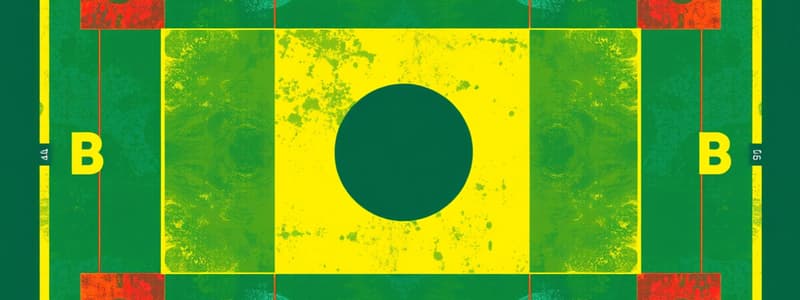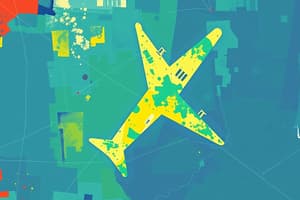Podcast
Questions and Answers
What does an Alert Area designation look like?
What does an Alert Area designation look like?
An A followed by numbers, such as A-65.
What differentiates Controlled Firing Areas (CFAs) from other hazard zones?
What differentiates Controlled Firing Areas (CFAs) from other hazard zones?
- They are charted on sectional charts.
- They have radar or spotter aircraft that send alerts. (correct)
- They don't pose a threat to aircraft.
- They are always closed to air traffic.
What should a remote pilot do before flying in a military operation area (MOA)?
What should a remote pilot do before flying in a military operation area (MOA)?
Obtain clearance from air traffic control and contact the agency that controls the MOA.
What is required before operating a drone in Restricted Airspace?
What is required before operating a drone in Restricted Airspace?
UAV operations in restricted areas are always prohibited.
UAV operations in restricted areas are always prohibited.
Where would you look for information about restricted airspace R-2531?
Where would you look for information about restricted airspace R-2531?
Class A airspace begins at what altitude?
Class A airspace begins at what altitude?
What type of flights are allowed in Class A airspace?
What type of flights are allowed in Class A airspace?
How are the altitude boundaries of Class B airspace displayed on sectional charts?
How are the altitude boundaries of Class B airspace displayed on sectional charts?
What is the typical ceiling of Class B airspace?
What is the typical ceiling of Class B airspace?
What class of airspace is overlying the Dallas Fort Worth airport?
What class of airspace is overlying the Dallas Fort Worth airport?
A solid blue line on a sectional chart tells you that?
A solid blue line on a sectional chart tells you that?
What is the typical ceiling of Class C airspace?
What is the typical ceiling of Class C airspace?
What type of clearance is required before entering Class C airspace?
What type of clearance is required before entering Class C airspace?
What is the typical ceiling of Class D airspace?
What is the typical ceiling of Class D airspace?
What airspace details are represented by a thick, shaded magenta line with a gradient on a sectional chart?
What airspace details are represented by a thick, shaded magenta line with a gradient on a sectional chart?
What is Class G airspace?
What is Class G airspace?
What type of airspace is Special Use Airspace?
What type of airspace is Special Use Airspace?
What are Prohibited Areas?
What are Prohibited Areas?
What are Warning Areas?
What are Warning Areas?
What are Military Operation Areas (MOAs)?
What are Military Operation Areas (MOAs)?
What are Alert Areas?
What are Alert Areas?
A shaded magenta line indicates that Class E airspace begins at?
A shaded magenta line indicates that Class E airspace begins at?
A dashed magenta line indicates that Class E airspace begins at?
A dashed magenta line indicates that Class E airspace begins at?
Flashcards are hidden until you start studying
Study Notes
Class A Airspace
- Extends from 18,000 feet MSL to 60,000 feet MSL.
- All flights must operate under Instrument Flight Rules (IFR).
- Extends 12 NM from the coast of the contiguous U.S. and Alaska.
Class B Airspace
- Surrounds the busiest airports in the U.S., depicted as an upside-down wedding cake.
- Requires ATC authorization before entry.
- Typically has a ceiling of 10,000 feet MSL.
- Manned aircraft must have a Mode-C transponder.
Class C Airspace
- Serves mid-sized airports, consisting of two rings: a surface area (up to 4,000 feet) and a shelf area (1,200 feet AGL to 4,000 AGL).
- Requires prior ATC authorization for entry.
- Typical ceiling is 4,000 feet AGL.
Class D Airspace
- For smaller airports with control towers, typically extends to 2,500 feet above the airport.
- Requires two-way radio communication with the control tower before entry.
- Ceiling is depicted on sectional charts as MSL.
Class E Airspace
- Any controlled airspace that isn't Class A, B, C, or D.
- Starts at either the surface or 700 feet AGL, extending up to but not including 18,000 feet MSL.
- Shaded magenta line indicates 700 feet AGL, while dashed magenta line indicates the surface.
Class G Airspace
- Uncontrolled airspace where no ATC services are provided.
- UAS operations are allowed without prior authorization.
- Class G becomes Class E at 1,200 feet AGL up to 18,000 feet MSL.
Special Use Airspace
- Includes areas like Prohibited, Restricted, Warning, Military Operation Areas (MOAs), Alert Areas, and Controlled Firing Areas (CFAs).
- Prohibited Areas: No flying allowed; marked with "P" and number.
- Restricted Areas: Generally IFR flights allowed if airspace is released; marked with "R" and number.
- Warning Areas: Alert pilots to potential hazards and can start within 3 NM of U.S. coast; marked with "W" and number.
- MOAs: Designated for military operations; civilian traffic is not prohibited but caution is advised.
- Alert Areas: Noted with "A" and number, indicate unusual aerial activity.
- CFAs: Potentially hazardous areas with alerts; not shown on charts.
General Clearance Requirements
- Class C airspace requires prior ATC clearance.
- Class D airspace mandates establishment of radio communication before entry.
- Class E may require authorization depending on the floor level and nearby airports.
Operations and Safety
- Remain aware of nearby airspace types and requirements when conducting operations.
- Always check sectional charts for specific altitude and operational guidelines.### Authorization for Drone Operations
- Obtain authorization from the controlling agency before operating in restricted airspace R-5403.
- According to 14 CFR Part 107.45, drone operators must have permission to fly in restricted areas, which differs from regulations for manned aircraft.
- For inquiries regarding R-5403, contact 1-800-972-8824 for information.
UAV Operations in Restricted Areas
- UAV operations are rarely permitted in restricted airspace without approval from the controlling agency.
- Approval for UAV flights in restricted areas is a rare occurrence.
Finding Information on Restricted Airspace
- To gather information about restricted airspace, such as R-2531, refer to the Notes to Sectional Charts located on the borders of paper sectional charts.
- The FAA does not provide a visual representation of this information on sectional chart printouts, as indicated in Figure 74.
UAV Operations in Special Use Airspace
- Not all UAV operations are prohibited in special use airspace; this statement is false.
- UAV operators can conduct flights in prohibited airspace if permission is obtained from the controlling agency, although such instances are uncommon.
Studying That Suits You
Use AI to generate personalized quizzes and flashcards to suit your learning preferences.




